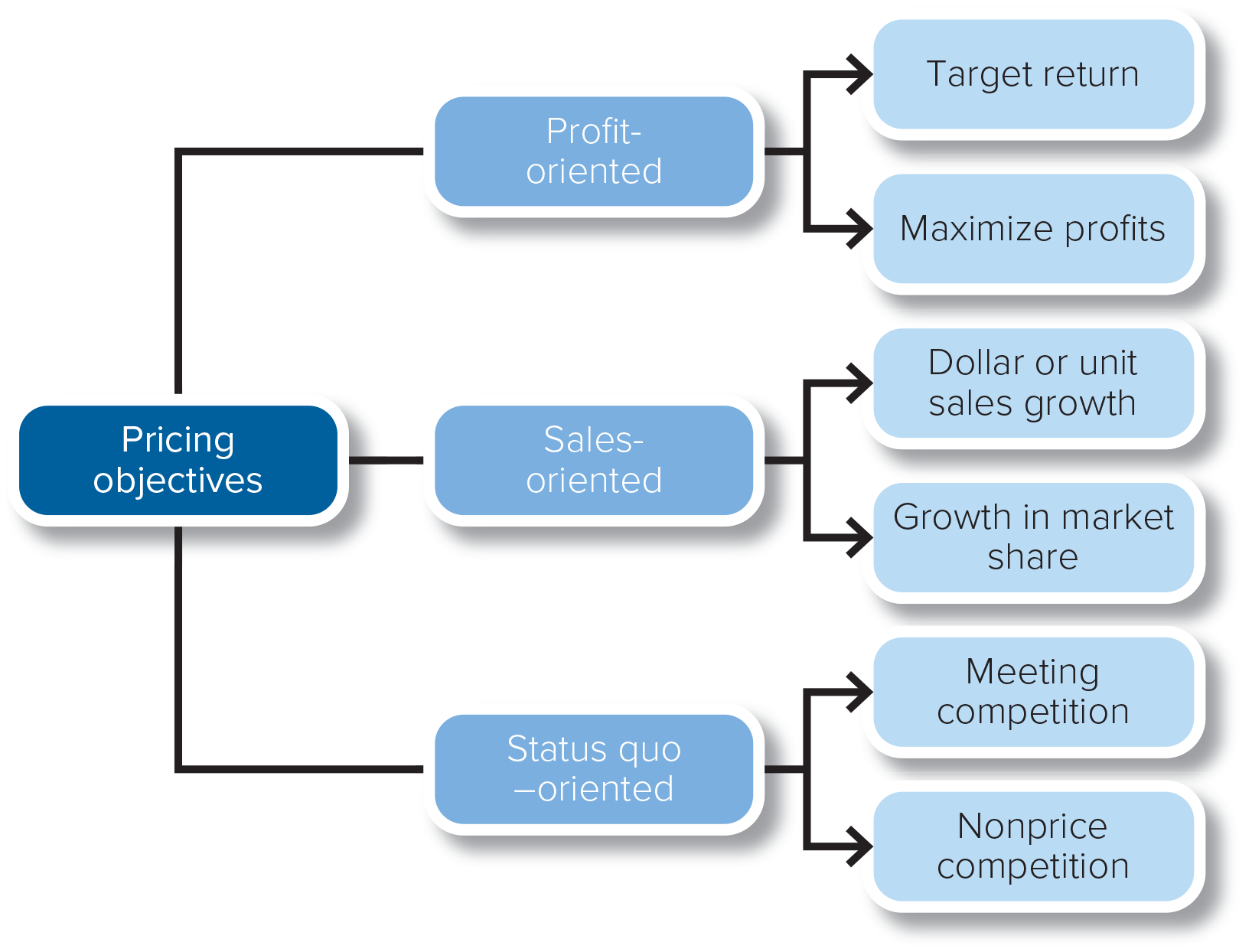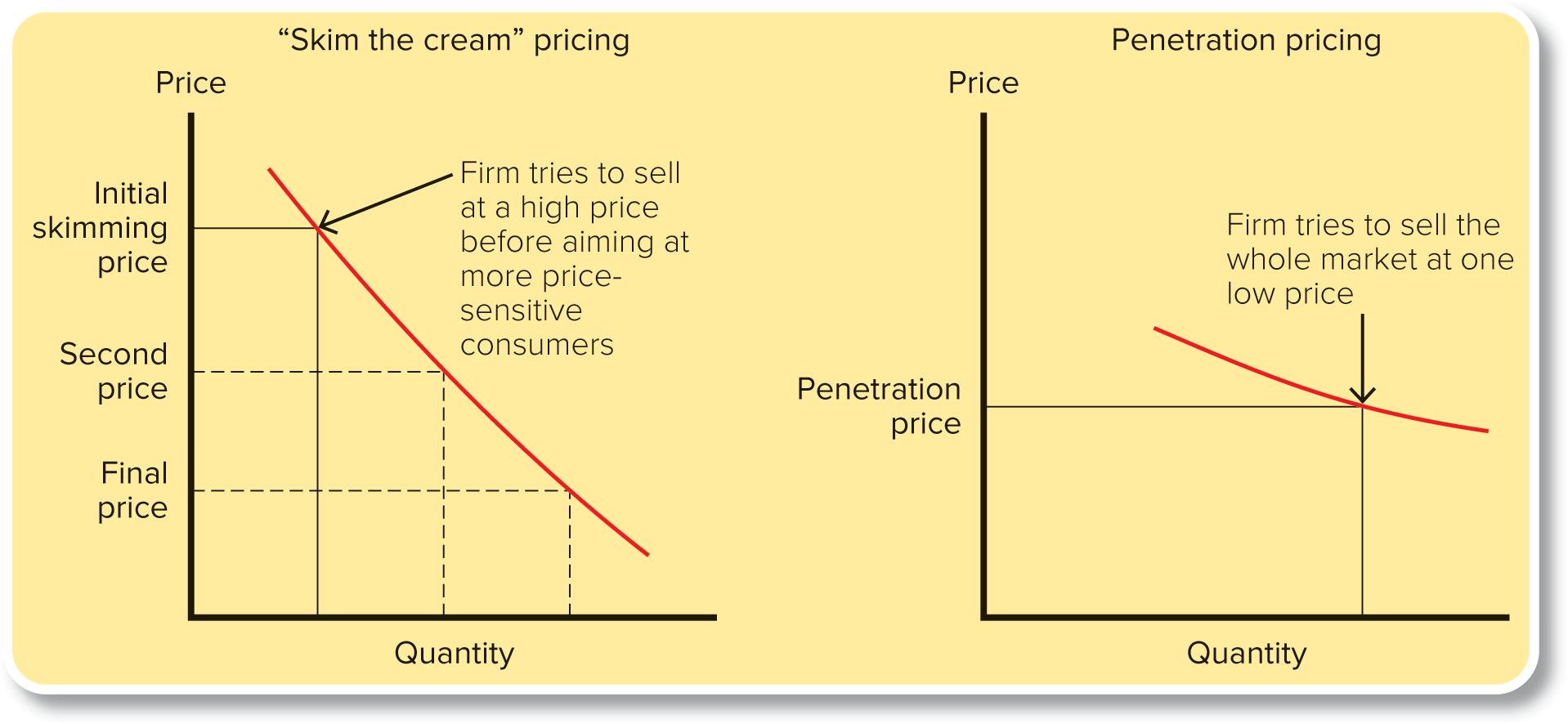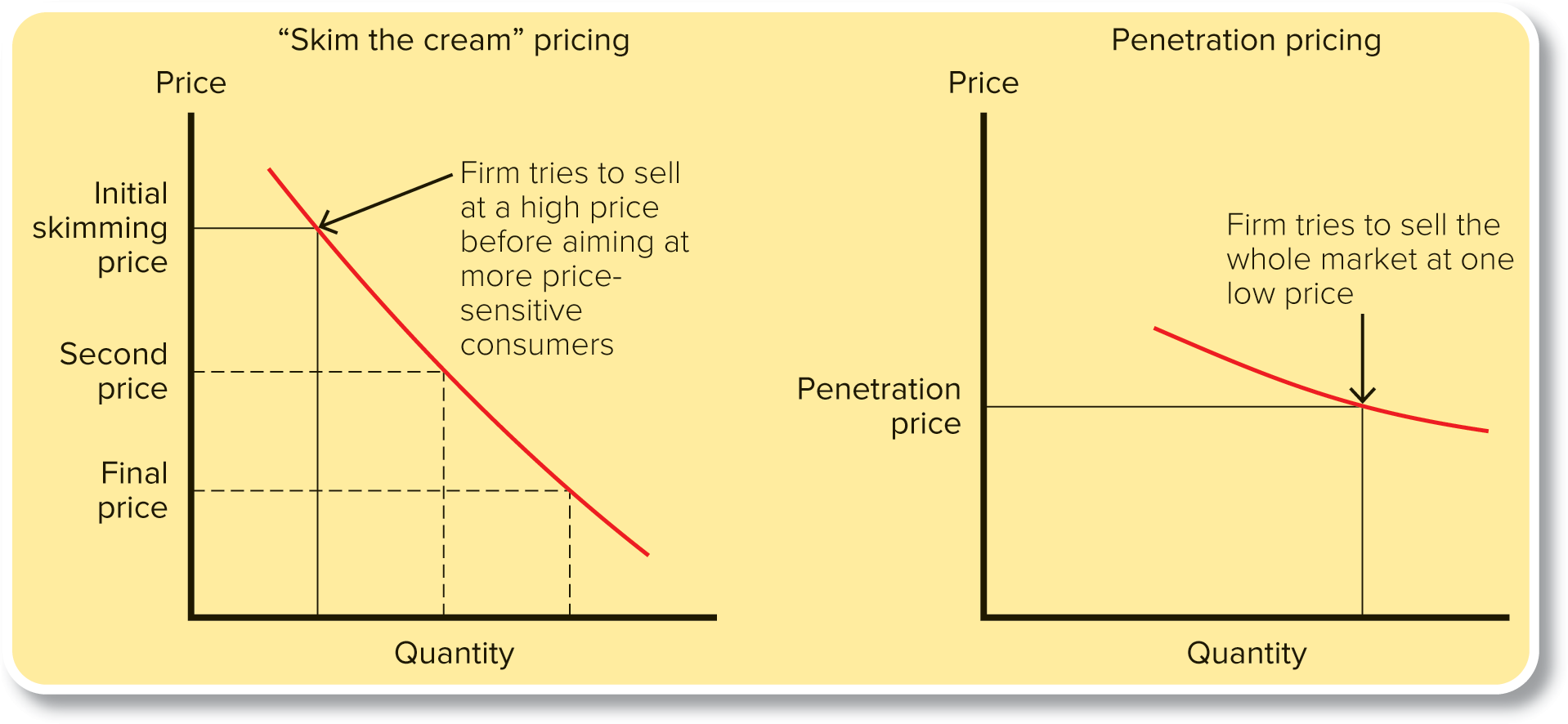MKT CH 17
1/83
There's no tags or description
Looks like no tags are added yet.
Name | Mastery | Learn | Test | Matching | Spaced |
|---|
No study sessions yet.
84 Terms
These Objectives drive decisions about key pricing policies:
How flexible prices will be
The level of prices over the product life cycle
To whom and when discounts and allowances will be give
How temporary price reductions, financing, and transportation costs influence customer behavior
Price
The amount of money that is charged for “something” of value
Pricing Objectives
Profit Oriented
Target Return
Maximize Profits
Sales Oriented
Dollar or Unit Sales Growth
Growth in Market Share
Status Quo Oriented
Meeting Competition
Nonprice Competition

Target Return Objective
A specific level of profit as an objective
Profit Maximization Objective
An objective to get as much profit as possible
Benefit Corporation
A legal corporate structure that allows for goals that may include positive impacts on society, employees, the community, and the environment
B Corporation Certification
A private certification that a corporation meets a high standard for social and environmental performance
Sales-Oriented Objective
An objective to get some level of unit sales, dollar sales, or share of market - without referring to profit
Sales-Oriented Objective works
over the short term
when products are in the introductory or early growth stages of the product life cycle
A company with a longer-run view may aim for
increased market share when the market is growing
A larger market share, if gained at too
low a price, may lead to profitless “success”
Status Quo Objectives
“Don’t-rock-the-pricing-boat” objectives
Managers with Status Quo Objectives may
want to stabilize prices
meet competition
avoid competition
A Status Quo Objective may be part of an aggressive overall marketing strategy focusing on Nonprice Competition
Aggressive action on one or more of the Ps other than Price
Price policies usually lead to Administered Prices
Consciously set prices aimed at reaching the firm’s objectives
If a firm doesn’t sell directly to final customers, it usually wants to
administer both the price it receives from intermediaries and the price final customers pay.
One-Price Policy
Offering the same price to all customers who purchase products under essentially the same conditions and in the same quanitites
The majority of U.S. firms use a One-Price Policy -
mainly for administrative convenience and to maintain goodwill among customers.
Flexible-Price Policy
Offering the same product and quantities to different customers at different prices
Dynamic Pricing
Pricing products at a particular customer’s perceived ability to pay
The idea of dynamic pricing is to optimize revenue and profit by
charging higher prices to customers willing to pay more & lower prices to those who don’t see value at the high price but will buy at lower prices
Skimming Price Policy
Trying to sell the top of the market - the top of the demand curve - at a high price before aiming at more price-sensitive customers
Skimming Price Policies may maximize profits in the
market introduction stage for an innovation, especially if there are few substitutes or if some customers aren’t price sensitive
Skimming Price Policies are useful when
you don’t know very much about the shape of the demand curve
A Skimming Policy often involves a
slow reduction in price over time

Penetration Pricing Policy
Trying to sell the whole market at one low price
A Penetration Pricing Policy might be wise when the
elite market -those willing to pay a high price - is small. This is the case when the whole demand curve is fairly elastic

Penetration Pricing may be wise if the firm expects
strong competition very soon after introduction
Introductory Price Dealing
Temporary price cuts to speed new products into a market and get customers to try them
Competition begins to impact pricing more in the
market growth and market maturity stages
In the sales decline stage,
new products come in to replace the old. Prices will likely decline in the shrinking market.
(Basic) List Prices
The prices that final customers or users are normally asked to pay for products
Discounts
Reductions from list price given by a seller to buyers who either give up some marketing function or provide the function themselves
Quantity Discounts
Discounts offered to encourage customers to buy in larger amounts
2 Kinds of Quantity Discounts
Cumulative
Noncumulative
Cumulative Quantity Discounts
Reductions in price for larger purchases over a given period, such as a year
Cumulative Discounts encourage
repeat buying by reducing the customer’s cost for additional purchases
A Cumulative Quantity Discount is often attractive to
business customers who don’t want to run up their inventory costs.
Noncumulative Quantity Discount
Reductions in price when a customer purchases a larger quantity on an individual order
Noncumulative Discounts encourage
larger orders but do not tie a buyer to the seller after that one purchase
Seasonal Discounts
Discounts offered to encourage buyers to buy earlier than present demand requires
If Seasonal Discounts are used by a manufacturer,
it tends to shift the storing function along in the channel and even out sales over the year
Service firms that face irregular demand or excess capacity often use
seasonal discounts
Net
An invoice term meaning that payment for the face value of the invoice is due immediately.
Cash Discounts
Reductions in the price to encourage buyers to pay their bills quickly
2/10, net 30
Allows a 2 percent discount off the face value of the invoice if the invoice is paid within 10 days
Trade (Functional) Discount
A list price reduction given to channel members for the job they are going to do
Allowances
Reductions in price give to final consumers, customers, or channel members for doing something or accepting less of something
Advertising Allowances
Price reductions to firms in the channel to encourage them to advertise or otherwise promote the firm’s products locally
Stocking Allowances aka Slotting Allowances
Allowances given to wholesalers or retailers to get shelf space for a product
Stocking Allowances are commonly used
to get supermarket chains to handle new products. Supermarkets are more willing to give space to a new product if the supplier will offset their handling costs and risks.
Push Money (or Prize Money) Allowances
Allowances(aka PMs or spiffs) given to retailers by manufacturers or wholesalers to pass on to the retailers’ salesclerks for aggressively selling certain items.
Push Money Allowances are used for
new items, slower-moving items, or higher-margin items. They are often used for pushing furniture, clothing, consumer electronics, and cosmetics.
Trade-in Allowance
A price reduction given for used products when similar new products are bought
Trade-ins give the marketing manager an easy way to
lower the effective price without reducing list price
Marketing managers often use different Price tactics to motivate customers to action
Temporary price reductions
Adding convenient ways to finance or pay
How transportation costs are handled
Sale Price
A temporary discount from the list price
Sale Price discounts encourage
immediate buying
In other words, to get the sale price, customers give up
the convenience of buying when they want to buy and instead buy when the seller wants to sell
Special sales provide a marketing manager with
a quick way to respond to changing market conditions without changing the basic marketing strategy
Everyday Low Pricing
Setting a low list price rather than relying on frequent sales, discounts, or allowances
A variation of targeted price reductions are Rebates -
Refunds to consumers after a purchase
Coupon and Rebates give a producer a way to certain that final consumers
actually get the price reduction
A firm might use coupons or rebates to
segment the market
Installment involves making
small payments over time - usually with interest payments built in
Mobile Payments
Payments made at the point of purchase using a mobile device
Lease
An agreement that gives a customer the right to use something for a specified period of time in exchange for regular payments
Value Pricing
Setting a fair price level for a marketing mix that really gives the target market superior customer value
In making price decisions and using value pricing, it is important to clearly define the
relevant target market and competitors when making price comparisons
The value customers perceive can be measured as price premium
that is, the percentage by which a price exceeds (or falls short of)a benchmark price
Unfair Trade Practice Acts
Legislation that puts a lower limit on prices, especially at the wholesale and retail levels
Dumping
Pricing a product sold in a foreign market below the cost of producing it or at a price lower than in its domestic market
Phony List Prices
Misleading prices that customers are shown to suggest that the price they are to pay has been discounted from list
Wheeler-Lea Act
Law that bans unfair or deceptive acts in commerce
Price Fixing
Competitors illegally getting together to raise, lower, or stabilize prices.
Robinson-Patman Act
A 1936 law that makes illegal any price discrimination if it injures competition
Price Discrimination
Injuring competition by selling the same products to different buyers at different prices
The law does permit some price differences - but they must be based on
cost differences
the need to meet competition
The Robinson-Patman Act allows a marketing manager to charge different prices for similar products if
they are not of “like grade and quality”
The FTC says that if the physical products characteristics of a product are similar,
then they are of like grade and quality
The Robinson-Patman Act allows price differences if there are
cost differences - say, for larger-quantity shipments or because intermediaries take over some of the physical distribution functions
Under the Robinson-Patman Act, meeting a competitor’s price is permitted as
a defense in price discrimination cases
Some firms violate the Robinson-Patman Act by
providing push money, advertising allowances, and other promotion aids to some customers and not others.
The Robinson Patman Act prohibits such special allowances, unless
they are made available to all customers on “proportionately equal” terms